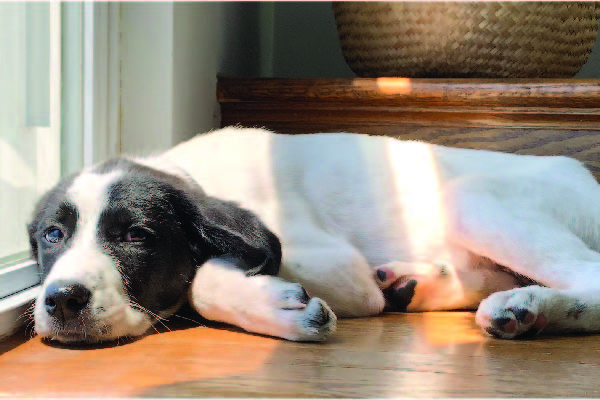START NOW
Returning To Work, A Guide For You And Your Dog
Mar 09, 2021

As COVID-19 vaccinations continue to roll out and Chicago residents slowly but surely return to the office, there’s one furry family member who might be more affected than you’d think: your anxious pup.
Joanne Kim, PAWS Chicago foster and current foster mom to anxious dog, Lacey, knows firsthand how difficult it can be to address separation anxiety. “I’m a little nervous about returning to the office if/when covid gets better,” said Joanne. “[But] I think right now, it’s probably the most ideal time to address the separation anxiety knowing I am home and able to set boundaries.”
As Joan Harris, PAWS Chicago’s Director of Canine Training and Behavior, suggests, one of the very best boundaries you can set is with crate training! Although crate training can seem emotionally taxing for both pup and person (Joanne says Lacey’s not yet a fan of her crate), creating a safe space and teaching your dog that they’re safe when you’re gone leads to a happier, healthier life for everyone.
If you expect a change in your schedule soon, start setting expectations with your dog now. “Dogs are creatures of habit who crave a regular schedule and want to know what their expectations are, just like children!” said Joan. Jumping from spending 24/7 together to being alone for eight+ hours a day will be confusing for your dog, so you need to help manage their expectations. “If you mix it up too much too quickly, they will get confused and you can expect their behavior to change,” Harris said. Taking small steps now will benefit your dog in the long run.
CREATE A SAFE SPACE – CRATE TRAINING
Start by creating a safe space for the dog to call its own – their crate. When you begin to leave the house for long periods of time, your dog will need a safe space to spend their time. Even if you have previously crate trained your dog, it is advisable to brush up on that training if he or she has not spent time in their crate during the Stay at Home period.
Crate Training Basics:
Begin to crate the dog with someone home for short periods to prevent the association with the crate and being left alone. Start by leaving the room for five to 10 minutes, then gradually work up to about 30 minutes. Getting the dog used to being alone while in the crated is a great first step!
Next, get your dog used to being crated with no one home. Put the dog in the crate with a rewarding treat, like a stuffed Kong, about 15 minutes before leaving. Don’t make a big deal of your departure; keep it low key and ignore your crated pup. The same follows on the return home. Wait until your dog is settled before opening the crate and keep both their and your excitement to a minimum.
Slowly increase the time the dog can be left alone from 15 minutes to 5 or 6 hours for an adult dog. This is the maximum time a dog should be crated. For a full workday schedule, employ a dog walker to come in to allow the dog time out of the crate to relieve itself and take a walk.
Be patient! Crate training can take several days or even weeks to complete. The goal is to associate the crate with something positive and avoid making the experience unpleasant for your pet. If successful, many dogs come to love the den-like atmosphere of a crate and will choose to sleep inside when the door is left open.
Read more in our Crate Training Protocol.
INTRODUCE SHORT INDEPENDENT BREAKS
Begin introducing your dog to your normal routine. Once they’re comfortable in their crate, practice leaving the house for short periods of time. Joan notes that “we encourage new adopters and fosters to work on crate training, and to take short jaunts out of the house, even to walk around the block without the dog, just to make sure they are not totally dependent on having someone around 24/7.” It’s tempting to take your furry pal along for each walk, but it’s more important in the long run to work on their independence training.
You can also consider leaving them in a different room with a high value treat while you work from home. With training, you can set them up for success and work on exercises to foster independence.
ENRICHMENT ACTIVITIES
If you’ve been going on more walks than usual, your dog is used to more physical and mental stimulation. As you start leaving the home for longer periods of time, introduce engaging toys and puzzles for your dog to explore and switch up your walking route for a change of scenery. Consider taking a class with the PAWS Chicago Training Center. Make the shorter time you spend together more engaging to keep your pup from getting bored!
ADDRESS ISSUES
The adjustment period after you return to work will be hard on you and your pup! You’ll miss their cute face and snuggles, and they’ll miss the extra love and attention.
You may notice signs of separation anxiety in your dog. Howling and continuous barking are most common, but also look for destructive behavior, trembling or salivating. If your dog is exhibiting any of these behaviors, reach out to the PAWS Chicago Training Center for additional help and training resources to help you and your pup transition to a new schedule.
